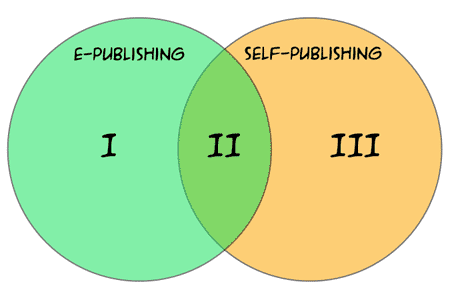For Your Consideration: The Venn Diagram Is Deceiving
I was on a panel at the Superstars Writing Seminar in Salt Lake City, and the panel attempted to cover self-publishing and e-publishing. Needless to say, there was more material than we could cover in an entire morning, let alone a one-hour discussion.
Here is a Venn Diagram which oversimplifies and may deceive you.

Most Venn diagrams lead us to believe that the intersection of two sets is an additive sort of thing, either a "best-of-both" or a "worst-of-both" scenario. Those familiar with the commercial publishing and self-publishing worlds will immediately realize that in the diagram above this is not the case.
Consider: Area I is where major publishers do business with Amazon's Kindle, Barnes & Noble's Nook, and all sorts of other options for creating electronic versions of mass-market works. It is where commercial publishers go electronic.
Area III is where I currently live, contracting print jobs of my own comics and selling them in a mad scramble to pay the bills before I'm buried under inventory.
Area II, the intersection, is its own animal. Self-published works exist alongside commercially published works, and the consumer currently struggles to tell the difference. What some laud as the leveling of the playing field others bemoan as a manifestation of Sturgeon's law.
I'm not sure, but I think that I've accidentally numbered these areas in descending order of revenue. Taken as an entire market, I makes more money than II, which makes more money than III.
I haven't drawn any conclusions here. I've drawn two circles that intersect. But it's worth noting that the next time I'm invited to be on a panel about e-publishing and self-publishing, I'm going to insist that we not attempt to cover areas I, II, and III at the same time. It's also worth noting that I need to create some products that fit in Area II. Some of you are prejudiced against shiny, gorgeous paper.
(*Note: I say "commercial publishing" where the vanity presses would have you say "traditional publishing." The latter is a term a vanity press coined to legitimize itself by slighting the organizations who pay their authors instead having their authors pay them. But that's a separate discussion.)


